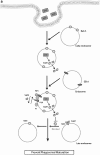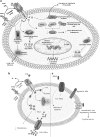Bacterial Virulence Factors: Secreted for Survival
- PMID: 28148975
- PMCID: PMC5243249
- DOI: 10.1007/s12088-016-0625-1
Bacterial Virulence Factors: Secreted for Survival
Abstract
Virulence is described as an ability of an organism to infect the host and cause a disease. Virulence factors are the molecules that assist the bacterium colonize the host at the cellular level. These factors are either secretory, membrane associated or cytosolic in nature. The cytosolic factors facilitate the bacterium to undergo quick adaptive-metabolic, physiological and morphological shifts. The membrane associated virulence factors aid the bacterium in adhesion and evasion of the host cell. The secretory factors are important components of bacterial armoury which help the bacterium wade through the innate and adaptive immune response mounted within the host. In extracellular pathogens, the secretory virulence factors act synergistically to kill the host cells. In this review, we revisit the role of some of the secreted virulence factors of two human pathogens: Mycobacterium tuberculosis-an intracellular pathogen and Bacillus anthracis-an extracellular pathogen. The advances in research on the role of secretory factors of these pathogens during infection are discussed.
Keywords: Anthrax; Bacillus; Mycobacterium; Phosphatases; Tuberculosis; Virulence.
Figures



References
Publication types
LinkOut - more resources
Full Text Sources
Other Literature Sources
